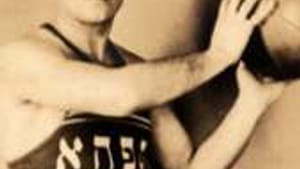Stay in the Loop
BSR publishes on a weekly schedule, with an email newsletter every Wednesday and Thursday morning. There’s no paywall, and subscribing is always free.
Once upon a time in the East
When Jews ruled basketball

The Philadelphia Sphas were America's outstanding basketball team from the 1920s to the end of World War II. They predated all-black teams like the Harlem Globetrotters and New York Renaissance. Their owner-coach, Eddie Gottlieb, subsequently helped organize the National Basketball Association.
Did I mention that the Sphas were an all-Jewish team that wore Hebrew letters on their uniforms in an era of widespread anti-Semitism? (The name is an acronym for "South Philadelphia Hebrew Association.") Owner-coach Eddie Gottlieb and his team attracted fans by flaunting the idea of a minority group battling "against the world."
"Half the crowds would come to see us win and the other half would come hoping to see us get killed," recalled Harry Litwack, a Sphas player who was Gottlieb's closest friend and, later, the long-time basketball coach at Temple University.
Small wonder that three books have recently appeared to explore this forgotten chapter in American sports history.
Stereotypes of weakness
Douglas Stark's new book, The SPHAs, documents the story in more detail than anyone has done before. He includes box scores and seasonal statistics, which Stark accessed through his job at the Basketball Hall of Fame in Springfield, Mass. Stark's book includes rare and vivid photographs of players as he describes how these Jews fought stereotypes of Jewish weakness and inferiority while spreading the popularity of what was then a relatively new game.
The Mogul, written in 2008 by the prolific sports historian Rich Westcott, examines the life of Gottlieb, who later owned the Philadelphia Warriors and functioned as the NBA's de facto chief executive. (In a masterpiece of mixed metaphors, Gotty once remarked that the NBA's president, Maurice Podoloff, "didn't know his ass from first base when it came to basketball.") Gottlieb also nearly became general manager and part owner of the Philadelphia Phillies.
Neal Pollack's novel, Jewball, meanwhile, focuses on a real Sphas player from the late 1930s, Inky Lautman (so-called because he had black hair). Pollack's book is populated with other real people connected to the Sphas, like the announcer Dave Zinkoff and the singer Kitty Kallen.
Pollack's fictional Lautman in 1937 saw crypto-Nazis from the anti-Semitic German-American Bund "hunched behind the basket in their khaki shirts... sipping rye from little silver flasks with swastikas on the sides." This fact-based novel then flies off into a giddy world of fictitious spies and adventure.
My mother's friends
All three books, unfortunately, are based largely on second-hand information. Stark researched The SPHAs after almost all of the original Sphas had died. (He did speak with many of their children.) Consequently, his book contains a few errors and omissions, of which I'm keenly aware because my mother went to school with the founders of the Sphas and taught in the Philadelphia school system alongside two of them, so that many of them became my friends.
Stark identifies Herman (Chickie) Passon as one of the team's three co-founders, along with Gottlieb and Hughie Black. But Chickie was the kid brother of the actual co-founder, Harry Passon.
Stark writes that Gottlieb changed his team's name to the Warriors in 1926 and entered them in a new league. Actually, those Warriors were created by the racketeer Boo Boo Hoff to become Philadelphia's franchise in a new, big-city American Basketball League, and he hired Gottlieb to coach the team. Simultaneously, Gottlieb continued to own and coach the Sphas, separately. Westcott's book tells the story accurately.
When players were "'cagers'
Nor do these books say enough about the wire cages that surrounded basketball courts before 1930. On outdoor playgrounds, a cage was needed to keep loose balls from bouncing into street traffic. Indoor courts were surrounded by chicken wire braced by two-by-four lumber to keep the ball from hitting spectators. (When the ball hit the cage, it was still in play.)
"You shoulda played when we had cages," Gottlieb once told me. "We used to bounce-pass the ball off of the wire, like racquetball. You'd come away from games with cage marks all over your body."
Thus was born the employment of "cagers" as a term to describe basketball players. It was still used when I wrote sports for my high school newspaper in the late 1940s. It worked for headlines because it was short. (We tried using "dribblers" but that sounded disgusting.)
As for Pollack's fictitious Jewball, let the record show that the real Inky Lautman was tall for those days, at six foot two— not "the smallest guy on the court," as Pollack describes him.
Maybe I should write my own book.♦
To read responses, click here.
Did I mention that the Sphas were an all-Jewish team that wore Hebrew letters on their uniforms in an era of widespread anti-Semitism? (The name is an acronym for "South Philadelphia Hebrew Association.") Owner-coach Eddie Gottlieb and his team attracted fans by flaunting the idea of a minority group battling "against the world."
"Half the crowds would come to see us win and the other half would come hoping to see us get killed," recalled Harry Litwack, a Sphas player who was Gottlieb's closest friend and, later, the long-time basketball coach at Temple University.
Small wonder that three books have recently appeared to explore this forgotten chapter in American sports history.
Stereotypes of weakness
Douglas Stark's new book, The SPHAs, documents the story in more detail than anyone has done before. He includes box scores and seasonal statistics, which Stark accessed through his job at the Basketball Hall of Fame in Springfield, Mass. Stark's book includes rare and vivid photographs of players as he describes how these Jews fought stereotypes of Jewish weakness and inferiority while spreading the popularity of what was then a relatively new game.
The Mogul, written in 2008 by the prolific sports historian Rich Westcott, examines the life of Gottlieb, who later owned the Philadelphia Warriors and functioned as the NBA's de facto chief executive. (In a masterpiece of mixed metaphors, Gotty once remarked that the NBA's president, Maurice Podoloff, "didn't know his ass from first base when it came to basketball.") Gottlieb also nearly became general manager and part owner of the Philadelphia Phillies.
Neal Pollack's novel, Jewball, meanwhile, focuses on a real Sphas player from the late 1930s, Inky Lautman (so-called because he had black hair). Pollack's book is populated with other real people connected to the Sphas, like the announcer Dave Zinkoff and the singer Kitty Kallen.
Pollack's fictional Lautman in 1937 saw crypto-Nazis from the anti-Semitic German-American Bund "hunched behind the basket in their khaki shirts... sipping rye from little silver flasks with swastikas on the sides." This fact-based novel then flies off into a giddy world of fictitious spies and adventure.
My mother's friends
All three books, unfortunately, are based largely on second-hand information. Stark researched The SPHAs after almost all of the original Sphas had died. (He did speak with many of their children.) Consequently, his book contains a few errors and omissions, of which I'm keenly aware because my mother went to school with the founders of the Sphas and taught in the Philadelphia school system alongside two of them, so that many of them became my friends.
Stark identifies Herman (Chickie) Passon as one of the team's three co-founders, along with Gottlieb and Hughie Black. But Chickie was the kid brother of the actual co-founder, Harry Passon.
Stark writes that Gottlieb changed his team's name to the Warriors in 1926 and entered them in a new league. Actually, those Warriors were created by the racketeer Boo Boo Hoff to become Philadelphia's franchise in a new, big-city American Basketball League, and he hired Gottlieb to coach the team. Simultaneously, Gottlieb continued to own and coach the Sphas, separately. Westcott's book tells the story accurately.
When players were "'cagers'
Nor do these books say enough about the wire cages that surrounded basketball courts before 1930. On outdoor playgrounds, a cage was needed to keep loose balls from bouncing into street traffic. Indoor courts were surrounded by chicken wire braced by two-by-four lumber to keep the ball from hitting spectators. (When the ball hit the cage, it was still in play.)
"You shoulda played when we had cages," Gottlieb once told me. "We used to bounce-pass the ball off of the wire, like racquetball. You'd come away from games with cage marks all over your body."
Thus was born the employment of "cagers" as a term to describe basketball players. It was still used when I wrote sports for my high school newspaper in the late 1940s. It worked for headlines because it was short. (We tried using "dribblers" but that sounded disgusting.)
As for Pollack's fictitious Jewball, let the record show that the real Inky Lautman was tall for those days, at six foot two— not "the smallest guy on the court," as Pollack describes him.
Maybe I should write my own book.♦
To read responses, click here.
What, When, Where
The SPHAS: The Life and Times of Basketball's Greatest Jewish Team. By Douglas Stark. Temple University Press, 2011. 344 pages; $29.50. www.amazon.com.
The Mogul. By Rich Westcott. Temple University Press, 2008. 320 pages; $39.00. www.amazon.com.
Jewball. By Neal Pollack. Published as an electronic book by Amazon.com. 258 pages; $10.07. www.amazon.com.
Sign up for our newsletter
All of the week's new articles, all in one place. Sign up for the free weekly BSR newsletters, and don't miss a conversation.

 Steve Cohen
Steve Cohen